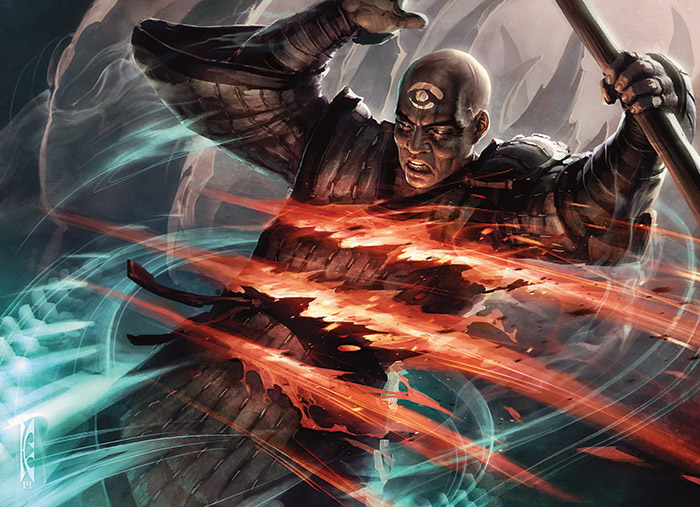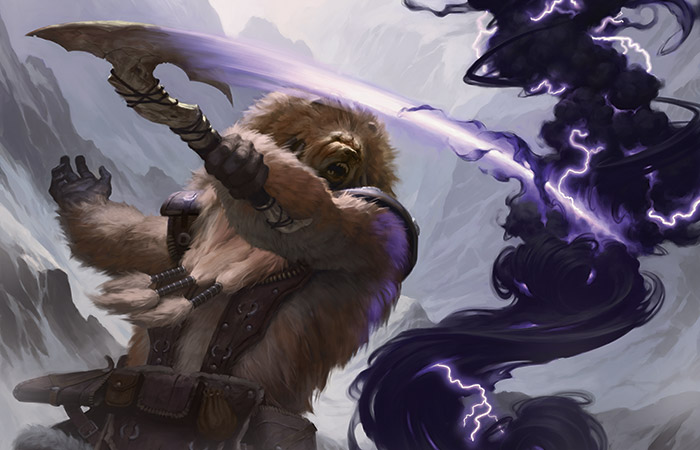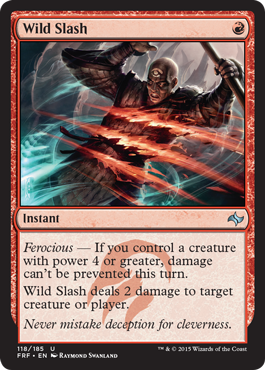Role Assignment
Being adaptable is key in Magic. Knowing how to defend yourself is useful, as is knowing how to be aggressive and close out a game. However, you can't make full use of your skills if you don't always know when you ought to be employing each one.
Once you know the basics of Magic, you're able to decide whether you want to play offense or defense in a game. The problem, however, is that many players make this decision far too early. It's natural to fall into this trap because right from the point that you lay out your cards to build a deck, you do so with the plan of being either aggressive or controlling.
Of course, it's wise to construct your deck with a game plan in mind. That said, it's essential to be able to alter and reevaluate that game plan. Going into a particular matchup, you might realize that your normal game plan isn't going to work and that you'll have to adapt. Other times, you'll have to make similar evaluations as the texture of the game begins to change.
Today, we're going to discuss adaptability, and more specifically the concept of role assignment. We'll also go over the types of cards that can make your deck more flexible and more able to function under a variety of circumstances. At the end, I'll preview a card from Fate Reforged that fits well into this category.

Art by Raymond Swanland
In 1999, Mike Flores, my predecessor as Level One columnist, posed perhaps the most poignant question in all of Magic theory, "Who's the Beatdown?" His question is, in other words, which player ought to be attacking and which player ought to be defending?
Answering this question correctly won't guarantee victory. However, answering wrong—or worse yet, failing to ask at all—will most certainly lead to a quick and convincing loss. Do not try to race against an opponent who can output damage faster than you. Do not try to outlast an opponent with a stronger late game. Identify whether you ought to be forcing the action or trying to extend the game, and act accordingly.
The question of who's the beatdown is tied closely to inevitability. If one player has inevitability, the opponent most certainly ought to be "the beatdown," because if he or she is not, the game will steadily move toward a state where the opponent can no longer win.
Looking at things from the opposite perspective, the question is also closely tied to which player is capable of winning faster. This player will have an edge in the early game and will virtually force his or her opponent into playing defensively. Identify the point in the game where your advantage is greatest, and center your strategy around it.
Blocking with Stormbreath Dragons
Let's take a look at the Temur deck that Jeremy Frye played to the Top 8 of Grand Prix San Antonio.
This deck uses the early turns to develop its mana via Sylvan Caryatid or Rattleclaw Mystic, and then begins to deploy single creatures capable of unloading lots of damage very quickly.
Undoubtedly, Mr. Frye built this deck with aspirations of attacking with Stormbreath Dragons on turn four, knocking away his opponents' life points huge chunks at a time, and winning many of his games right around turn six. This is, in fact, what the Temur deck does...
Most of the time...
There's a small problem, which is that some decks in Standard are capable of winning before turn six. Temur's plan A game plan works like a charm against slower decks. It's powerful and consistent, and the presence of cards like Stubborn Denial and Temur Charm can shut down whatever defensive measures the opponent was hoping to employ. Against faster decks, though, the strategy must be reevaluated.

Stubborn Denial | Art by James Ryman
Round after round, you get used to making the same plays. Turn-two Sylvan Caryatid, turn-three Savage Knuckleblade and attack with haste, turn-four Stormbreath Dragon and attack with both. The first five times, it works exactly as planned, but in that sixth match you might never untap for your fifth turn. Why not? Because your opponent dealt you 20 damage and you lost the game! Decks like Mono-Red and WU Heroic are simply faster than Temur, and trying to race against them is a losing battle.
What you have to do instead is to go off-plan and do something that your deck wasn't built for, which is to defend yourself. You have to be willing to cast your Stormbreath Dragon and not attack, as strange as it may feel to do so.
Needless to say, Temur isn't great at playing defense, but having even a small chance is much better than dying without a fight. Try to identify quickly when a plan is not going to work and look around for alternatives, even if they aren't particularly appealing.
Moreover, sideboards can be tremendously helpful in this regard. Jeremy Frye's sideboard featured Anger of the Gods and Magma Spray. These are not merely "good cards" against Mono-Red; they contribute to a complete reversal of strategy, changing you into a defensive deck designed to handle a fast creature onslaught. Now you can use a single big blocker to hold the ground, and as soon as your opponent develops his or her board enough to attack past it, Anger of the Gods can clean up the mess.
Mirror Matches and Limited
In many cases, who's the beatdown? is an easy question; one deck will be clearly faster and more aggressive than the other. It gets more complicated when the two decks look similar, and when role assignment can be fluid as the game progresses.
The most common example is Limited Magic (Sealed Deck or Booster Draft) where both decks will likely have elements of both offense and defense. Both decks will have creatures on a balanced mana curve with removal and other spells to support them. In such cases, you'll have to decide your role not only based on the matchup between the two decks, but also on what cards are drawn and how the board develops. You may have to adjust your game plan as the game progresses.
Similarly, sometimes decks of comparable speed will be forced to play against each other. Mono-Red and WU Heroic are both fast decks designed for racing. At what point will one player have to reign in the aggression and start leaving back blockers?
An even easier example is a mirror match—i.e., when both players are playing with the same deck archetype. Mono-Red players aren't used to blocking or voluntarily trading off their creatures, but in a mirror match, they might be forced to do so.
In these borderline situations, what factors contribute to role assignment? The first and simplest one is simply which player goes first. Recall:
"If the decks are of comparable speed, the player who goes first will have an advantage in the early stage. Last week, I touched on the fact that mirroring your opponent's plays when you're on the draw is typically a losing battle. You'll start out behind, and you'll remain behind for the whole game. In order to "break serve," the player on the draw will have to trade resources, slow the game down, and try to get to the late stage on even footing (or as close to it as possible)."
In more concrete terms, Johnny's Foundry Street Denizen, if he's on the play, will usually unload damage faster than Jenny's Foundry Street Denizen, if she's on the draw. Jenny should identify herself as needing to play defense and trade creatures right away instead of trying to damage race.

The second factor is precisely what cards each player draws. Whose opening hand is better? Which player misses a land drop? Which player draws a bunch of creatures and which draws a bunch of removal spells?
Don't be afraid to press an early advantage. Sometimes your opponent's draft deck might be a bit faster and more aggressive than yours, but that doesn't eliminate the chance of you having a faster draw than your opponent! If you have a one-drop, a two-drop, and a three-drop creature while your opponent plays nothing in the early turns, it might be best to take on the role of the aggressor and try to keep your opponent on the back foot so he or she can't turn the tables on you.
Then again, once your opponent starts playing creatures, it might be right to switch back to playing defense; the question depends on a variety of factors. Maybe your opponent's deck is constructed in a way that he or she can still beat you in a race despite a slow start. Maybe you have a bomb card in your hand that you think will win you the game as long as you can survive to cast it. Maybe some minor differences between the two decks mean that you have inevitability, or at least a noticeable advantage as the game goes long. In any of these cases, you might consider taking on a defensive role.
The third factor is a perceived advantage in the late game. In an exact mirror match, this might not exist. However, maybe you've sideboarded in three copies of Chandra, Pyromaster for the Mono-Red mirror, and you feel that she'll be able to pull you ahead if the game goes long. In such a case, you'll be slightly more inclined to play defense.
This will come up more often in Limited, where the presence of a bomb rare might make you want to drag the game out. It also works in the opposite direction. If you lost Game One to your opponent's Duneblast, you might decide that you have to close out Games Two and Three before he or she draws it, in which case you'll have to play the role of "the beatdown."
It's important to remember that there can be a bit of fluidity in role assignment. The way your two decks match up matters a lot, but once in a while it can be outweighed by the cards drawn in a particular game. Your deck might be aggressive, but if your opponent has a fast start you simply have to play defense. You never know what might happen in a game of Magic, and the longer you keep yourself alive, the more unexpected opportunities for victory might arise.
Building Your Deck to be Flexible
The major strength of midrange decks is their flexibility. Midrange decks can play a control game against fast decks and can play the role of the aggressor against slow decks. Many factors contribute to this quality, including a balanced game plan and a sideboard that helps its pilot perfect his or her deck for any matchup. However, a lot of it comes down to individual card choices as well.
Some cards have flexibility built into them. Midrange decks strive to find cards that play effective defense, but can also turn on their opponents when the time comes to go for the throat.
Creatures that gain you life or excel at blocking are great when you're playing defense. If they also pack a punch when your opponent fails to mount a defense, then they're perfect for most midrange decks.
Versatile answer cards are also great. You can use them to remove an attacker, or you can use them to create an opening for a threat of your own.
Removal spells generally add to the flexibility of your deck. Having control over the creatures on the board means being able to slow down your opponent's offense or take out a blocker in order to keep attacking.
The problem comes when you face dedicated control decks, which simply might not have many targets for your removal spells. This is why it's particularly valuable to choose burn spells as your removal. When there's no creature that you need to answer, you can simply point them at your opponent!
Burn spells are great for aggressive and midrange decks alike, and they're at their best when you master the concept of role assignment. They're capable of stopping an attacker, taking out a blocker, or going straight after your opponent's life total. When you know which choice to make, burn spells will help you win the maximum possible number of games.
Preview Card: Wild Slash

One-mana burn spells are as old as the game itself, and yet it's always exciting when a new one is printed. It's always exciting because they're almost invariably important cards for both Constructed and Limited!
Long-time players always compare new burn spells to older ones. In the case of a new one-mana burn spell, the question is where does it fall relative to the tried-and-true Shock? Shock tends to be a staple card, and I've certainly played with burn spells far worse than Shock. Wild Slash is noticeably better! It always has at least the same effect as Shock with the potential for much more!
It's difficult to pinpoint the specific applications of Wild Slash's damage prevention clause without knowing everything about Fate Reforged. However, one obvious one from old Standard comes up against Kiora, the Crashing Wave. Let's say my Stormbreath Dragon's been targeted by Kiora's +1 ability and is slated to have its damage prevented this turn. I can Wild Slash my opponent or one of his or her creatures, and because the Dragon gives me ferocious, I can now successfully attack and kill Kiora!
Another interesting interaction comes up with the protection ability. Protection "reduces damage from a source to 0," which is another way of saying that it "prevents the damage." Remember that Wild Slash cannot target a creature with protection from red, but its ability can allow a Slagstorm to kill it or a red creature to deal damage to it in combat. Are you sure you want to block my Ember Swallower with your Master of Waves? I'll Wild Slash you for 2 damage, and I'll kill your Master and all of your Elemental tokens! Look for this to come up against God's Willing and Feat of Resistance out of WU Heroic as well.
Such a deck isn't popular right now, but every once in a while someone shows up with the nefarious strategy which goes by the name "Turbo-Fog." Turbo-Fog decks cast cards like Fog or Defend the Hearth every turn of the game, either by drawing lots of extra cards or somehow recurring cards from their graveyards. The best way to foil this strategy is to stop damage prevention, and Wild Slash is an easy way to do that.
The need to stop damage prevention comes up often, in places you wouldn't always think of. I expect Wild Slash to be a big card in Standard and Limited, simply by virtue of its similarity to Shock. It's a good, efficient card that provides flexibility to decks that might not know ahead of time what role they'll need to take in a game of Magic. Its damage prevention clause might have important applications either in Standard or in older formats, and is something that's well worth keeping in mind. Use it well!

